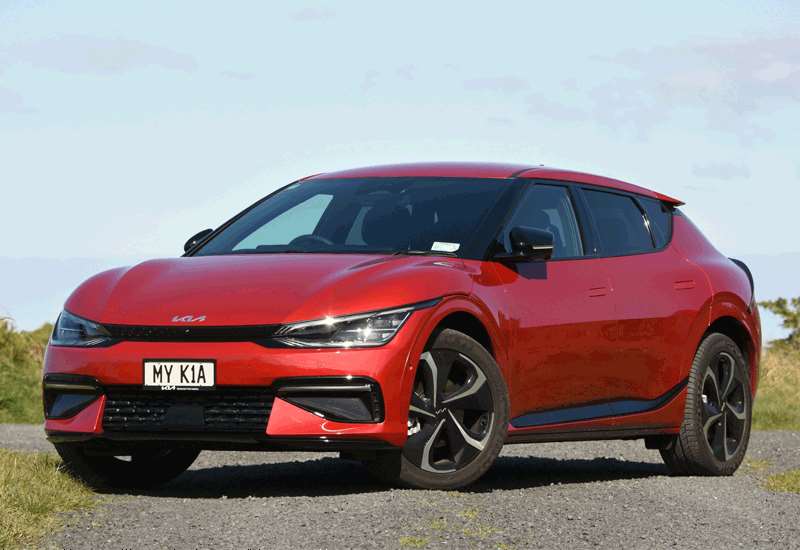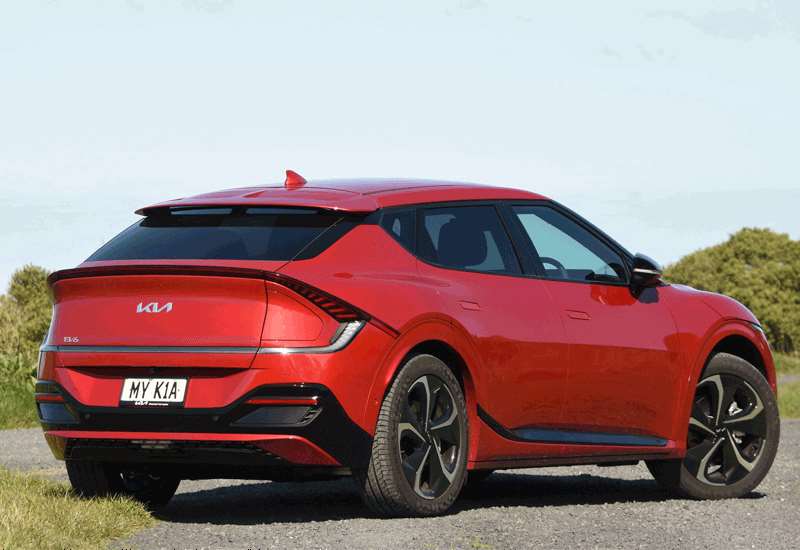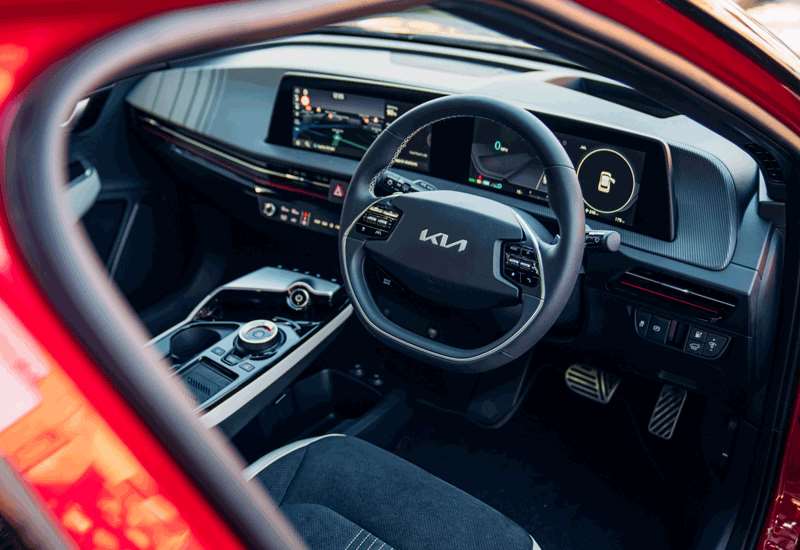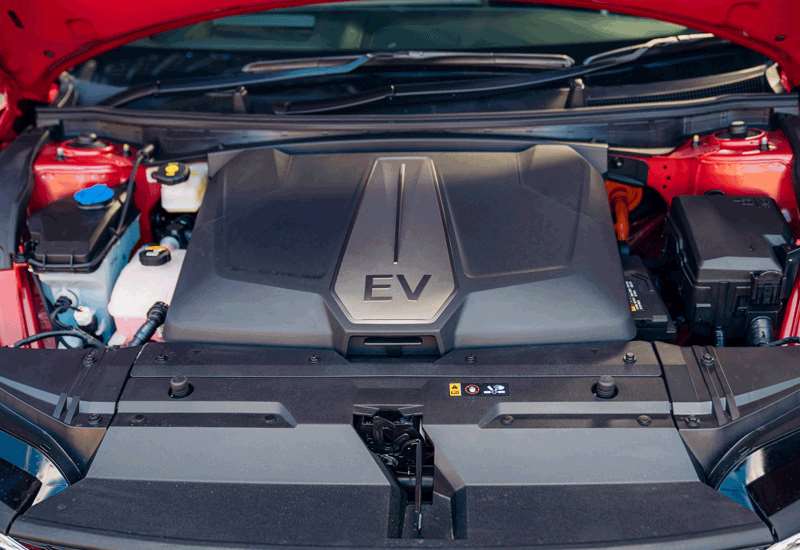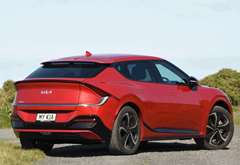Hyundai’s Ioniq 5 is already New Zealand’s Car of the Year, now the arrival of its cousin, the Kia EV6, has provided a high point of the 2022 automotive year. David Thomson checks in after time behind the wheel on local roads.
What’s new?
Kia’s push for a chunk of the burgeoning EV market has gathered pace this year with the launch of the EV6. While not the first Kia model offered with a battery-powered drivetrain, it is the first available solely in electric guise.
Though an utterly different vehicle, the EV6 supersedes the sporty petrol-powered Stinger as the flagship of the Kia range. It also follows on from Hyundai’s Ioniq 5 as the second of several vehicles that will use a new underlying platform designed solely for EVs.
Moving to a dedicated EV platform is significant in design terms, most obviously because it enables a far longer wheelbase relative to the vehicle’s overall length.
While sharing a common platform and deploying a near-identical choice of EV drivetrains, the EV6 and Ioniq 5 are otherwise quite different machines. Visually, the EV6’s sleek and contemporary lines contrast markedly with the futuristic boxiness of the Ioniq 5. Both are substantial machines, but while sharing a common 2900mm wheelbase,
Kia’s EV6 is 60mm longer and 50mm lower.
Kia offers four variants within the Kiwi EV6 family.
The EV6 Air is the single-motor, rear-drive option, available in standard-range guise with a 125kW/350Nm motor and 58kWh battery pack, or in extended-range form, with a 77.4kWh battery pack and 168kW/350Nm motor. Priced at $75,990 and $78,900 respectively, both models meet the sub-$80k threshold to qualify for a Clean Car rebate.
The $99,990 Earth and $111,990 GT-Line are both fitted with the 77.4kWh battery pack, delivering power to all four wheels via a 239kW/610Nm dual-motor set-up.
An even more spectacular standard bearer, the pure EV6 GT, has been confirmed for launch early next year.
Carrying a $139,990 tag, this version will pack a 430kW/ 740Nm punch, and its 0-to-100kmh sprint time of 3.5 seconds and top speed of 260kmh will make it the quickest ever Kia road car.
Back in the here-and-now, Kia supplied the current GTLine flagship for this appraisal.
What comes as standard?
The standard EV6 safety suite includes adaptive cruise control, lane-keep assist, lane following assist, blind-spot monitoring, rear cross-traffic alert, traffic sign recognition, intersection assist and autonomous emergency braking with car, pedestrian, and cyclist detection. Extra safety items reserved for the AWD variants are parking collision avoidance assist, a blind sport view monitor, and a full 360-degree surround-view camera system.
A fully-digital dual-widescreen touchscreen and instrument cluster take pride of place on the dash of all variants.
Kia’s ‘‘Vehicle to Load’’ system is also fitted across the range, enabling the car to serve as power source for a range of electrical appliances and power tools.
Even the standard EV6 is well equipped with items such as keyless entry and start, sat nav, a power-operated driver’s seat, plug-in points front and rear, and wireless phone charging and connectivity.
Both AWDs take remote self-parking functionality, a head-up display, a heated steering wheel, and heated front sports seats. The GT-Line goes further with suede upholstery, seat chillers, a premium 14-speaker Meridian sound system, a heat pump system, alloy pedals, interior mood lighting, and dual adaptive LED headlights.
High-tech is the name of the game here, for the most part brilliantly executed. However, advanced systems can sometimes be too clever for their own good. For example, the test car’s ‘‘smart opening’’ function for the tailgate automatically activated on test as I walked past the hatch to the driver’s door. That would have been fine, but for the fact the EV6 was parked in a garage at the time. Thus, for the first time in my road-testing life, a vehicle self-harmed, in this case by bashing its tailgate into the raised garage door.
What’s it like to look at?
Technically the EV6 is classified as an SUV, and in terms of size and heft that tag is justified. However, like Jaguar’s i-Pace, the EV6 blurs conventional boundaries in being styled more as a large sports hatchback.
Sitting on 20-inch alloys, and finished in Runway Red paint, the test car attracted plenty of attention on a test, which included, by chance, a brief encounter in Waihola with what I understand is the only other red EV6 in this part of the country.
What’s it like inside?
A striking and practical free-floating centre console, laser-etched highlighting panels, and the twin-screen digital display, are some of the more eye-catching features in a cabin that combines an innovative and contemporary look with everyday practicality.
The dash and dual-screens are curved towards the driver. This gives a wrap-around feel to the cabin from the driver’s seat.
Many of the trim surfaces are formed from re-constituted plastic bottles, with Kia’s official blurb saying that recycled plastics equivalent to 107,500ml water bottles are used on each EV6 interior.
The back seat set-up is very good, with sufficient room to carry three adults in reasonable comfort, and ample space for two.
What’s it like to drive?
The EV6’s drive modes — eco, normal, sport and snow — are selectable via a button on the steering wheel, and deliver contrasting experiences.
Thanks to the ability of electric motors to deliver maximum power instantly, without any need to ‘‘spool up’’, even eco mode endows the EV6 GT-Line with reasonable pep for effortless round town and highway motoring. Normal mode ups the anti noticeably, while sport mode provides kick-in-the-pants acceleration, including a 0-100kmh sprint time of 5.2sec.
There is ample steering heft, but while the helm is precise in action, it lacks feel. On the other hand, the ability to control regenerative braking through four levels of intensity via the paddle shift toggles opens the way for very engaging and efficiency-maximising single-pedal driving.
An absence of mechanical noise comes as no surprise on an EV, but what impressed me most about the test car’s aural refinement was the banishment of wind roar and excellent suppression of tyre rumble.
The location of the car’s heaviest item, the battery pack, very low on the chassis and between the wheels pays dividends in enabling the EV6 to corner flat, and maintain impressively neutral balance even when pressed to corner hard.
The EV6’s suspension set-up feels sharper and more dynamically resolved than its Hyundai counterpart.
Ease of EV motoring?
Drivesouth relied on a conventional three-pin plug for home charging on test, but this is a very slow way to charge a 77.4kWh battery pack. Owners should install a higher-capacity wall box for economical home-based overnight charging at up to 11kW per hour.
Commercial charging is fuss-free on the 50kW rapid chargers that are common in southern New Zealand. The EV6 is also compatible with the next-generation 800-volt 300kW ‘‘hyperchargers’’, which can add 100km of range in five minutes of charging and take an EV6 battery from 10% to 80% of charge in under 20 minutes. New Zealand’s first hyperchargers are already operating in the upper North Island, and installations in Christchurch, Dunedin and Queenstown are scheduled for the coming months.
Range-wise, the EV6 GT-Line is rated at 484km on the WLTP test. An extended highway run from Dunedin inland in reasonable weather and with four adults on board produced a 22.5kWh/100km, which points to a fine real-world open road range of 300-350km.
Verdict
It has taken Drivesouth nine months to award its first five-star overall road test rating for 2022, and the EV6 GT-Line has earned that rare accolade with relative ease. An exceptional addition to Kia’s range, it sets a formidable benchmark for the Korean company as its rollout of electric vehicles gathers strength.
- David Thomson
